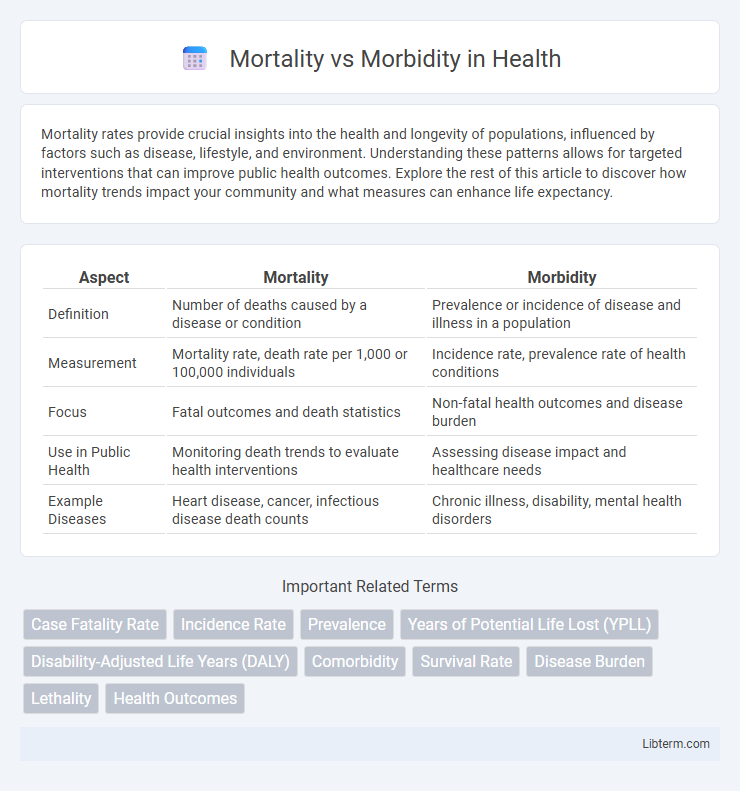Mortality rates provide crucial insights into the health and longevity of populations, influenced by factors such as disease, lifestyle, and environment. Understanding these patterns allows for targeted interventions that can improve public health outcomes. Explore the rest of this article to discover how mortality trends impact your community and what measures can enhance life expectancy.
Table of Comparison
| Aspect | Mortality | Morbidity |
|---|---|---|
| Definition | Number of deaths caused by a disease or condition | Prevalence or incidence of disease and illness in a population |
| Measurement | Mortality rate, death rate per 1,000 or 100,000 individuals | Incidence rate, prevalence rate of health conditions |
| Focus | Fatal outcomes and death statistics | Non-fatal health outcomes and disease burden |
| Use in Public Health | Monitoring death trends to evaluate health interventions | Assessing disease impact and healthcare needs |
| Example Diseases | Heart disease, cancer, infectious disease death counts | Chronic illness, disability, mental health disorders |
Understanding Mortality and Morbidity
Mortality refers to the incidence of death within a population, often measured by mortality rate or crude death rate, providing critical data for public health assessment. Morbidity indicates the prevalence or incidence of diseases and health conditions affecting individuals, captured through metrics like morbidity rate and disease burden. Understanding mortality and morbidity together enables comprehensive evaluation of population health, guiding effective healthcare policies and resource allocation.
Key Differences Between Mortality and Morbidity
Mortality refers to the incidence of death within a population, measuring the frequency of fatal outcomes due to diseases or conditions, while morbidity denotes the prevalence or incidence of illnesses, injuries, or health complications impacting quality of life without necessarily leading to death. Key differences include mortality quantifying death rates and life expectancy impact, whereas morbidity assesses disease burden, disability, and healthcare resource utilization. Understanding these distinctions is critical for public health policy, epidemiological research, and resource allocation in healthcare systems.
Common Measures of Mortality
Common measures of mortality include the crude death rate, age-specific death rate, and cause-specific death rate, which quantify the frequency of deaths in a population over a specific period. The infant mortality rate and maternal mortality ratio are critical indicators used to assess healthcare quality and public health interventions. These mortality metrics enable epidemiologists and public health officials to track trends, identify risk factors, and allocate resources effectively.
Metrics Used to Assess Morbidity
Morbidity is primarily assessed using incidence and prevalence rates, which measure the frequency of new cases and the total number of existing cases of a disease within a specific population and period. Disability-adjusted life years (DALYs) and quality-adjusted life years (QALYs) are also critical metrics, quantifying the burden of disease by accounting for both morbidity and mortality impacts on overall health. These metrics provide essential data for public health planning, resource allocation, and evaluating the effectiveness of interventions targeting disease prevention and management.
Causes of High Mortality Rates
High mortality rates are often driven by factors such as infectious diseases, cardiovascular conditions, and respiratory infections, which remain leading causes of death worldwide. Poor healthcare infrastructure, limited access to medical services, and socio-economic disparities exacerbate the prevalence and fatality of these conditions. Addressing high mortality requires targeted interventions on these critical health determinants to reduce preventable deaths effectively.
Factors Contributing to Morbidity
Factors contributing to morbidity include lifestyle choices such as poor diet, physical inactivity, and tobacco use, which significantly increase the risk of chronic diseases like diabetes, cardiovascular conditions, and respiratory illnesses. Environmental exposures, including pollution and occupational hazards, also elevate morbidity rates by causing respiratory and infectious diseases. Furthermore, social determinants such as socioeconomic status, limited access to healthcare, and education disparities play a crucial role in the prevalence and management of morbidity.
The Impact of Morbidity on Quality of Life
Morbidity significantly diminishes quality of life by causing chronic pain, disability, and reduced physical and mental functioning. Unlike mortality, which refers to death rates, morbidity encompasses the prevalence of diseases and health conditions that impair daily activities and well-being. High morbidity rates are closely linked to increased healthcare costs, prolonged recovery times, and decreased productivity in affected populations.
Global Trends in Mortality vs Morbidity
Global mortality rates have declined significantly due to improvements in healthcare, sanitation, and vaccination programs, leading to increased life expectancy worldwide. However, morbidity trends show a rise in chronic and non-communicable diseases such as cardiovascular diseases, diabetes, and mental health disorders, reflecting lifestyle changes and aging populations. Epidemiological data emphasize a shift from infectious diseases to chronic conditions as the primary contributors to global disease burden and healthcare challenges.
Preventive Strategies for Reducing Mortality and Morbidity
Effective preventive strategies such as vaccination programs, regular health screenings, and lifestyle modifications significantly reduce both mortality and morbidity rates by preventing the onset of diseases and detecting conditions early. Public health initiatives targeting smoking cessation, balanced nutrition, and physical activity contribute to lowering chronic disease prevalence and associated death rates. Implementing these evidence-based interventions in healthcare policy and community programs enhances population health outcomes and decreases healthcare burdens globally.
The Importance of Mortality and Morbidity Data in Public Health
Mortality and morbidity data provide critical insights into the health status of populations, guiding public health strategies and resource allocation. Mortality statistics reveal the leading causes of death, enabling targeted interventions to reduce preventable deaths. Morbidity data highlight the prevalence and incidence of diseases, assisting in monitoring disease progression, evaluating healthcare effectiveness, and improving quality of life.
Mortality Infographic

 libterm.com
libterm.com